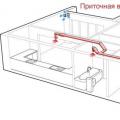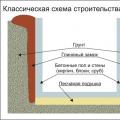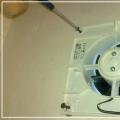When building a house, garage or any other outbuilding, many homeowners prefer houses with a basement. This is extremely convenient, because there is additional space for storing various useful things, and if you're lucky, you can equip, for example, a workshop here.
However, often construction is carried out according to an “economical” project or with a violation of technology, as a result, a terrible and destructive enemy appears in the basement - moisture. It gradually undermines the structure, and its constant companion - mold fungus - spoils not only the appearance and takes part in the destruction, but also causes significant harm to human health. The question arises, how to remove dampness in the basement?
Three reasons for dampness in the basement
Naturally, it is simply necessary to deal with all this, and first you need to find out the root of the problem. So, where can water and condensate come from in the basement, consider the main causes of dampness in the basement:
- capillary through walls, ceiling, floor;
- direct way through the cracks;
- condense from the air due to lack (or insufficiency) of ventilation.
Now that the enemy has been identified, you can proceed directly to the fight. Yes, before proceeding to work, the water from the basement, of course, must be pumped out and the room well ventilated, and, if possible, dried with a heat gun (fan, hair dryer).
Getting rid of cracks and capillary water in the basement
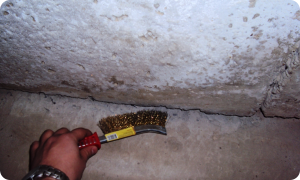 Cracks and cracks - the source of moisture in the basement
Cracks and cracks - the source of moisture in the basement To do this, carefully check all surfaces for the presence of large and small cracks. It may be necessary to completely or partially dismantle the heat-insulating coating of the walls, ceiling, remove the floor covering. Having found the place of violation of integrity, we carefully close it. Then we carry out waterproofing work. These works are divided into: internal (floor, ceiling, walls) and external.
Outdoor waterproofing
First you need to check the entire building from the outside, because very often the reason that the basement is flooded or simply damp is that the drainage system around the house is simply stupidly equipped.
It includes:
- slopes on the roof, windows, above the porch;
- downpipes of "directional action", that is, draining water into the funnel of an underground storm drain or at least into an above-ground gutter;
- drainage system around the walls of the house;
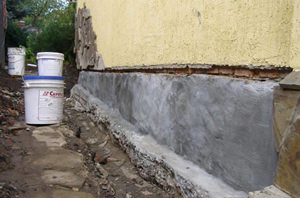 If all these components or at least part of them are absent, then this drawback must be eliminated. You should start from above, that is, from slopes and downpipes.
If all these components or at least part of them are absent, then this drawback must be eliminated. You should start from above, that is, from slopes and downpipes.
Now you can move on to the next step: protecting the underground part of the outer walls. For this:
- We remove the old blind area.
- Digging a hole a little more than half a meter wide beyond the outer walls of the basement (so that you can get into it and carry out work).
- Dry thoroughly the outer wall of the house (natural or forced).
- Coating the wall antifungal compounds (the choice in building stores is simply endless).
- Coating the wall(possible with clay, concrete based on liquid glass or with additives that reduce moisture absorption);
- Optional step: making an underground from a sheet of ruberoid. To do this, we fix it on the wall of the house 0.5 meters above the ground level and take it beyond the edge of the outer wall of the basement.
- We fill the hole.
- We equip the blind area(you can use any type of soft roof).
If serious excavation work is beyond your power, then for the first time you can get by with only the last item. At the same time, a soft roof sheet should partially go onto the wall of the building (somewhere by 50–70 cm), and it is important to fix it well, for example, with the same bitumen. The second edge should go beyond the edge of the underground basement wall by the same 50–70 cm.
Internal basement waterproofing
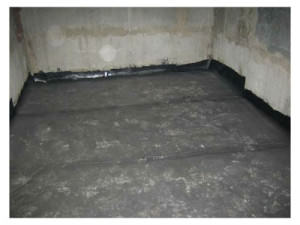 To get rid of dampness in the basement, you must:
To get rid of dampness in the basement, you must:
- Good first.
- Get rid of crumbling coatings.
- Clear cracks.
- Seal them with cement mortar.
- Soak the walls with an antifungal drug;
- Lubricate everything with a waterproofing solution (the simplest is bituminous mastic).
Pressure leaks, as well as their former places, must be very carefully repaired, for example, with alabaster.
To enhance the effect, you can plaster the walls completely or only partially 0.5–1 meter from the floor. But this step is not mandatory.
You can also make new walls from moisture-resistant material; in large basements, new brickwork is often built. There should be a minimum of 3 cm between the old and new wall. It is important to drill holes between the old and new walls so that the air from the basement can escape into the outside vents, and also so that moisture does not accumulate between the walls.
Dampness in the basement can also be provided by the old floor, even if it is a concrete screed. To remedy the situation, it is necessary to remove the decorative flooring, close up all the cracks in the concrete, if any. Then wait until everything dries, cover it with sand or expanded clay - the layer should be about 5 cm, and then lay roofing material or other waterproof durable material. After processing with bituminous mastic, you can make a new screed or lay logs, and on them - a plank floor.
Ventilation
Internal ventilation in the basement is a must. At the same time, it should be precisely the supply and exhaust. The simplest scheme: two pipes, one of which goes almost from the very floor of the basement and goes out under the ceiling, the second is located under the ceiling and also leads outside. The outer parts of the pipes must be protected from the ingress of melt and rain water.
Fighting mold fungus
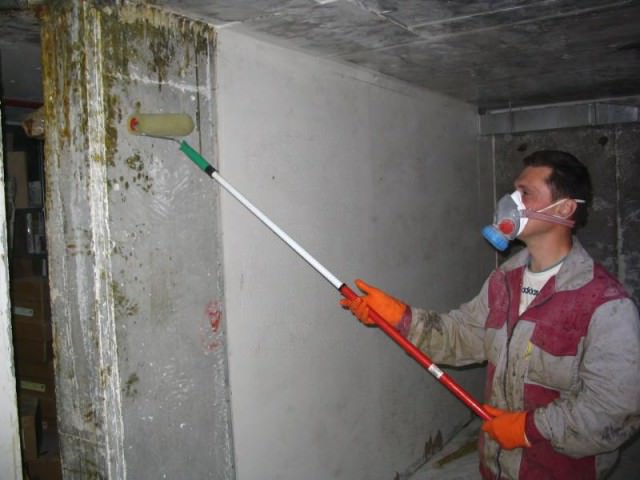 The two main enemies of mold are oxygen and dryness. The first we have already provided by arranging good ventilation. If for some reason this is not possible, then the basement should be ventilated as often as possible, but remember that the fungus will definitely return. The second can be provided by drying (industrial hair dryer, heat gun, heater). After drying, you can proceed to the treatment of walls, floors and ceilings with antifungal compounds.
The two main enemies of mold are oxygen and dryness. The first we have already provided by arranging good ventilation. If for some reason this is not possible, then the basement should be ventilated as often as possible, but remember that the fungus will definitely return. The second can be provided by drying (industrial hair dryer, heat gun, heater). After drying, you can proceed to the treatment of walls, floors and ceilings with antifungal compounds.
If you have a rather old building, and cracks still appear in the basement from time to time (in the corners, between bricks), then as a temporary measure, you can plug them with rags smeared with bituminous mastic and plaster them on top.
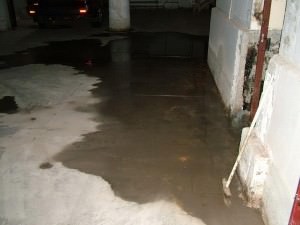 In the basement, where you need to pump out water, it is worth organizing a pit- a waterproof "glass" made of metal, concrete with waterproofing or other similar material. We will already pump water out of it with a pump.
In the basement, where you need to pump out water, it is worth organizing a pit- a waterproof "glass" made of metal, concrete with waterproofing or other similar material. We will already pump water out of it with a pump.
The floor in the basement should be at an angle, even if small, directed to one corner. In this corner is a pit. Then all the water will collect where we can easily fight it.
Express method for removing moisture and dampness in the basement
To quickly get rid of moisture, it is necessary to organize the collection of moisture with a hydrophilic substance (excellently absorbent). To do this, we take a board, put it at an angle in a bucket, sprinkle the board with hydrophilic powder (lime, alum, and so on). This method allows you to perfectly maintain dryness in the basement in the absence of the owners.
Blitz for the fastest
Briefly, all methods of dealing with dampness in the basement:
- We carry out external waterproofing works (rainfall, coating of external walls with bitumen, arrangement of a blind area)
- We remove mold.
- We carry out repair work to eliminate cracks.
- We make new waterproofing.
- Set up ventilation.
Having done all of the above, you can be sure that your home will be insured against the appearance of such an extremely undesirable phenomenon as dampness and mold, which can affect not only the basement, but also living quarters.

